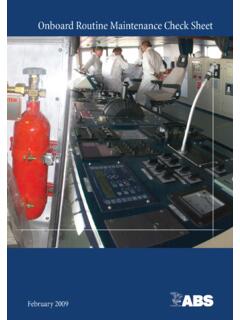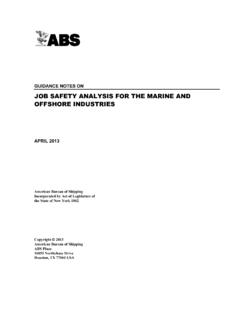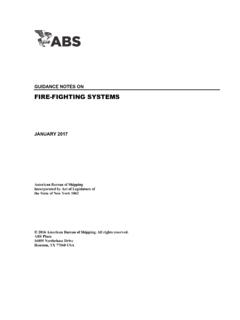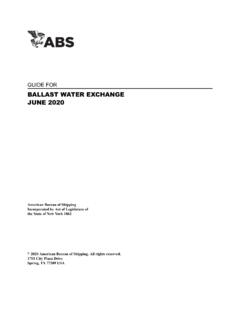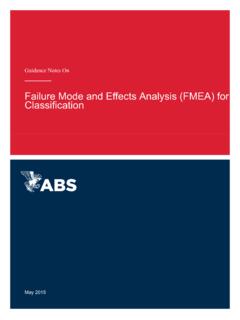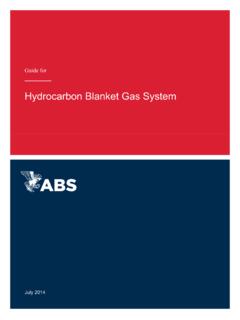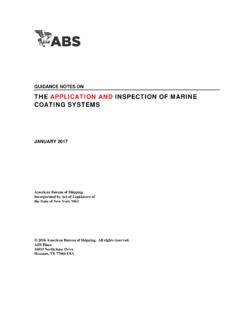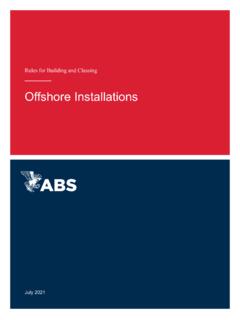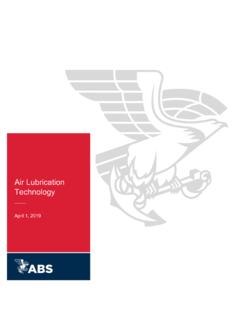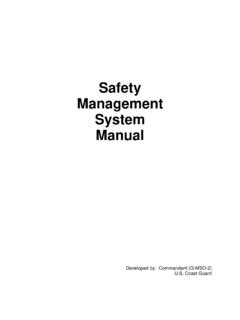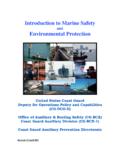Transcription of Guide for Implementation of International Safety Guide …
1 Guide for Implementation of International Safety Guide for Oil Tankers (ISGOTT) Guide FOR Implementation OF International Safety Guide FOR OIL TANKERS (ISGOTT) FEBRUARY 2016 (Updated January 2017 see next page) American Bureau of Shipping Incorporated by Act of Legislature of the State of New York 1862 2016 American Bureau of Shipping. All rights reserved. ABS Plaza 16855 Northchase Drive Houston, TX 77060 USA Updates January 2017 consolidation includes: February 2016 version plus Corrigenda/Editorials Foreword Foreword In addition to the ABS Rules for Building and Classing Steel Vessels (Steel vessel Rules) required criteria, this Guide outlines equipment and arrangement requirements that are identified in the International Safety Guide for Oil Tankers and Terminals (ISGOTT) for Oil Carriers.
2 This Guide includes enhanced criteria for the cargo oils and associated systems such as the ballast system, gas testing equipment, cargo vapor emission control systems, tank cleaning and gas-freeing systems. However, it does not include or attempt to address operational requirements for Oil Carriers as well as the requirements for terminals identified in the International Safety Guide for Oil Tankers and Terminals (ISGOTT) for Oil Carriers. This Guide also introduces an optional notation, ABS-ISGOTT that will be granted to those Oil Carriers that meet the requirements identified in this Guide .
3 This Guide is intended to encourage owners to pursue increased levels of Safety by providing means to recognize such efforts via an optional notation. It should also be noted that the Guide does not relate to cargoes other than crude oil and petroleum products that are carried in Oil Carriers. Therefore, it does not cover the carriage of chemicals or liquefied gases, which are the subject of other industry guides. This Guide becomes effective on the first day of the month of publication. Users are advised to check periodically on the ABS website to verify that this version of this Guide is the most current.
4 We welcome your feedback. Comments or suggestions can be sent electronically by email to ABS Guide FOR Implementation OF International Safety Guide FOR OIL TANKERS (ISGOTT) . 2016 iii Table of Contents Guide FOR Implementation OF International Safety Guide FOR OIL TANKERS (ISGOTT) CONTENTS SECTION 1 General .. 1 1 Introduction .. 1 3 Application .. 1 Vessels .. 1 Regulatory Requirements .. 1 5 Class Notations .. 1 7 Reference Documents .. 1 9 Plans and Details to be Submitted .. 2 SECTION 2 Cargo and Ballast Systems .. 3 1 Operations manual .. 3 3 Loading Rates .. 3 Venting Arrangements.
5 3 Flow Rates in Loading Lines .. 3 Rate of Rise of Liquid in the Cargo Tank .. 3 Loading Rates for Ballast Tanks .. 3 SECTION 3 Gas Testing Equipment .. 4 1 Alarm Functions on Gas Measuring Instruments .. 4 3 Sampling Lines .. 4 SECTION 4 Enclosed Spaces .. 5 1 Vapor Detection Equipment for Toxic Gases .. 5 3 Pump Room Communication Systems .. 5 5 Pump Room Operational Precautions .. 5 Maintenance of Electrical Equipment in the Pump Room .. 5 Additional Safety Systems and Arrangements .. 5 SECTION 5 Shipboard Operations .. 7 1 Cargo Vapor Emission Control (VEC) Systems .. 7 3 Tank Cleaning.
6 7 Tank Water Washing in a Non-Inert Atmosphere .. 7 Precautions for Tank Water Washing .. 7 iv ABS Guide FOR Implementation OF International Safety Guide FOR OIL TANKERS (ISGOTT) . 2016 5 Gas Freeing .. 8 Portable Fans .. 8 7 Crude Oil Washing .. 8 Cautionary Notice .. 8 9 Cargo Measurement, Ullaging, Dipping, and Sampling .. 8 Introduction of Equipment into a Tank .. 8 SECTION 6 Surveys After Construction .. 9 1 General .. 9 3 ABS-ISGOTT Notation .. 9 Annual Surveys .. 9 Special Periodical Surveys .. 10 ABS Guide FOR Implementation OF International Safety Guide FOR OIL TANKERS (ISGOTT).
7 2016 v This Page Intentionally Left Blank Section 1: General SECTION 1 General 1 Introduction This Guide provides criteria for the notation ABS-ISGOTT, which is offered to Oil Carriers which are provided with the supplementary equipment and arrangements specified herein. The requirements and notation identified in this Guide are optional for classification. Where the notation identified in this Guide is requested, the requirements herein are in addition to any and all applicable Oil Carrier requirements in the relevant ABS Rules and Guides as well as those in all applicable national or International regulations.
8 3 Application Vessels Self-propelled vessels classed in accordance with the ABS Rules for Building and Classing Steel Vessels (Steel vessel Rules) in Part 5A and Part 5B, Pt 2, Ch. 2 (Common Structural Rules for Double Hull Oil Tankers), Part 5C, Chapter 1 [Vessels Intended to Carry Oil in Bulk (150 meters (492 feet) or more in Length] or in Part 5C, Chapter 2 [Vessels Intended to Carry Oil in Bulk (under 150 meters (492 feet)] are eligible for the ABS-ISGOTT notation. Regulatory Requirements Compliance with regulatory requirements is considered a prerequisite for the optional notation.))
9 Therefore; vessels are to comply with all applicable IMO Safety requirements for the type of vessel involved. This may be established by the submittal of the appropriate IMO certificates or through independent verification by ABS. 5 Class Notations Vessels that meet the criteria in this Guide will be eligible to receive the optional notation ABS-ISGOTT. 7 Reference Documents Implementation of International Safety Guide for Oil Tankers (ISGOTT) ABS Rules for Building and Classing Steel Vessels (Steel vessel Rules) ABS Guide FOR Implementation OF International Safety Guide FOR OIL TANKERS (ISGOTT) . 2016 1 Section 1 General 9 Plans and Details to be Submitted The following documentation, as applicable, is to be submitted for review.
10 Operation Manuals for Cargo and Ballast systems Loading rate calculations for Cargo and Ballast tanks Details of gas measuring instruments and sampling system for the gas monitoring system Details of vapor detection equipment for toxic gas for the vessel carring oils containing Benzene Details of and operations manual for the pump room communications system Detailed maintenance instructions for the eletrical equipment in the pump room Details of and operations manual for fixed gas detection system in the pumproom Details of and operations manual for the oxygen sampling system Details of and operations manual for temperature monitoring devices Details of the high level bilge alarm system for pumproom Detail arrangements of the manually activated trips for the main cargo pumps Detail of the spray arrestors around the glands of rotary cargo pumps Cargo pump shaft seal arrangements and leakage alarm system Backup fire-fighting system for cargo pump room Arrangement of Emergency Escape Breathing Devices (EEBD)
